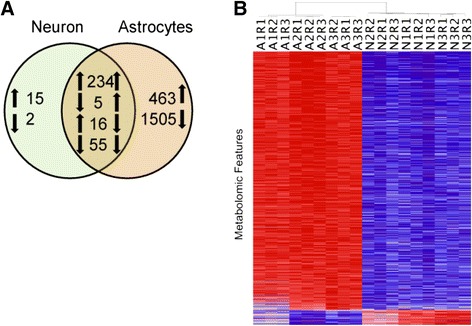Figure 2.

Unstimulated neurons and astrocytes have a distinct exometabolomic profile. (A) Venn diagram illustrating the number of features with significant differences between neurons versus control, and astrocytes versus control (P <0.05). Numerals denote the number of analytes reporting significantly different levels, while arrows denote directionality of change in comparison to controls (perfused chambers containing no cells). Note that the astrocytes show much higher metabolic activity than neurons, and that 94.8% of the changed neuronal metabolites are also observed in cultured astrocytes. Of the 2,278 species detected in the astrocyte-conditioned media, 69% were consumed, as compared to 19% in the neuronal media. (B) Clustering of unstimulated astrocytic and neuronal exometabolomic profiles. Heat map shows two-way unsupervised hierarchical clustering analysis of normalized metabolomics data for the features observed in astrocytes and neurons in their unstimulated state after subtraction of the peak areas for control media (for analytes, [see Additional files 6, 7, 8 and 9]). Columns represent biological and technical replicates (for example, A1R1 - astroglia biological replicate 1 technical replicate 1), rows represent individual chemical species identified by the ultra-performance liquid chromatography - ion mobility - mass spectrometry (UPLC-IM-MS). In individual features, red denotes higher metabolite production in comparison to the other cell type. Note that higher metabolite production was the predominant feature of the astrocytic cultures, and that the clustering separated the biological and technical replicates into two distinct neuronal and astroglial clusters.
